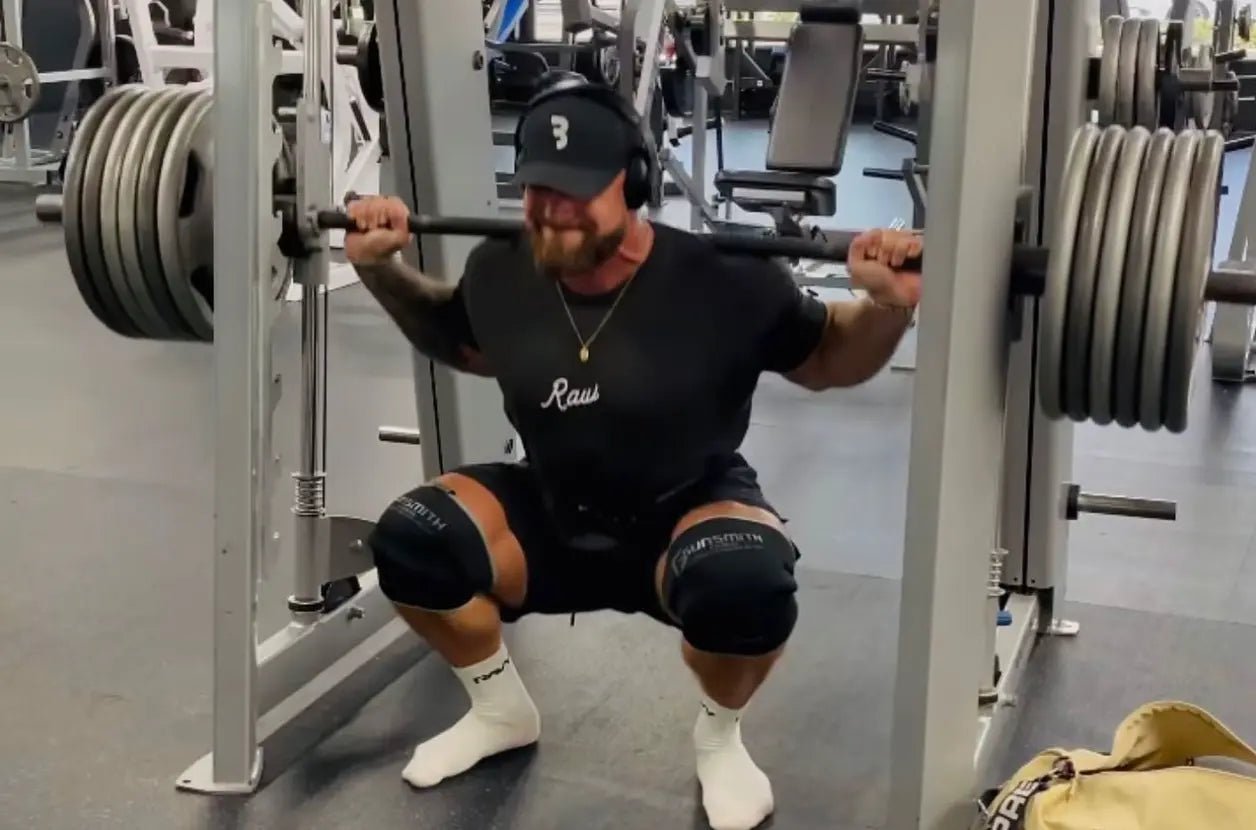
How Much Should I Be Able to Squat? 2023 Guide
How Much Should I Be Able to Squat: Squat Standards & More
Some time ago we did an article on How Much Should You Bench that proved to be incredibly popular. So this time we're going to be covering all things squat related, get yourself comfortable, this is going to be a big one!
When it comes to strength training and physical fitness, one common question often asked is, "How much should I squat?" Squats are a fundamental exercise that targets multiple muscle groups, including the quadriceps, hamstrings, glutes, and core muscles. Understanding the appropriate amount someone should be able to squat can provide valuable insight into their overall fitness level and strength.
Several factors can influence an individual's squatting abilities, such as age, gender, body weight, experience, and overall muscle strength. For example, beginners might aim to squat a lower weight, while more experienced lifters may strive for higher squat standards. To determine their one-rep max (1RM), individuals should perform squats with proper form, incrementally increasing the weight until their form breaks down, signifying their maximum capacity.
Strength standards, such as those provided by Strength Level, offer benchmarks for different genders and experience levels, with the average squat weight for a male lifter being 287 lb (1RM). However, it's essential to remember that each person's capabilities and goals are unique. Therefore, individuals should use these benchmarks as guidelines while considering their progress and fitness journey.
Check out our premium lifting belts.
Assessing Your Fitness Level - Average Squat Weight
Determining your fitness level in relation to squatting will help you set appropriate goals and effectively plan your workouts. There are three general categories for weightlifters - beginner, intermediate, and advanced. There's no need to whip out the calculator these will give an idea to determine how much weight is a good squat weight. We will review each of these categories, which can provide you with a baseline understanding of where you stand and what you should aim for.
Beginner
For those who are just starting their weightlifting journey, squatting may be a new and challenging exercise. It's important for beginners to learn proper form and technique to avoid injury and ensure effectiveness. According to Strength Level, male beginners should aim to lift about 141 lb (1RM), which is an impressive feat compared to the general population. Keep in mind that this weight includes the weight of the bar (typically 20 kg or 44 lb).
Intermediate
As you gain experience and develop your lifting abilities, you'll progress to the intermediate level. At this stage, your focus should be on increasing your squatting capacity while continuing to refine your form. The average squat weight for intermediate male lifters is 287 lb (1RM). Achieving this level of strength is a commendable accomplishment and illustrates significant progress in your fitness journey.
Advanced
Advanced weightlifters have honed their skills and consistently perform squats with excellent form and control. These individuals have typically been squatting for an extended period and have built a strong foundation of strength and technique. Becoming an advanced lifter requires dedication, discipline, and consistent effort. It's crucial to continue pushing your limits while prioritizing safety and proper form to reach the advanced level and maximize your potential.
Keep in mind that these categories and associated weights serve as general guidelines, and individual abilities may vary. Always prioritize your health, adhere to proper techniques, and consult a fitness professional when necessary to achieve optimal results in your weightlifting journey.
Check out our premium lifting belts.
Factors That Affect Squatting Ability
Squatting ability may vary from person to person depending on several factors. Improving your ability to squat may take time and practice, but understanding the elements that influence your squatting progression can help you make the right adjustments to reach your goals.
Age
With age, physical abilities such as strength and flexibility can decline, affecting squatting performance. However, continuing to practice squats throughout your life can help maintain muscle mass, bone density, and overall functional fitness.
Gender
Gender can play a role in squatting ability, as men and women may have different skeletal structures, muscle mass distribution, and hormone balance. These differences can affect the relative strength and form when performing squats, but consistent training can lead to improvements for both sexes.
Body Weight
Body weight is a significant factor when it comes to squatting since it directly impacts the ability to lift heavy loads. Those with a higher body weight may have more difficulty squatting initially, but consistent training and weight management can improve this ability over time.
Experience
Like any other skill, squatting ability improves with practice and experience. Beginners may find it challenging to maintain proper form and lift heavier weights, but with time and consistent training, their muscle strength, coordination, and proprioception will contribute to better squatting performance.
Mobility and Flexibility
Squatting requires good mobility and flexibility, especially in the ankles, hips, and knees. Those with limited mobility and flexibility may struggle to perform squats with proper form initially, but dedicated stretching and mobility exercises can lead to improvements.

Establishing Realistic Goals - Improve Your Squat
Setting Baselines
Before setting goals for squatting, it's essential to determine baselines for both men and women in terms of their current abilities and performance. The average squat weight for a male lifter is 287 lbs (1RM), making them intermediate on the strength level, while female beginners should aim to lift 141 lbs (1RM) as a starting point. These benchmarks can serve as initial goals to aim for and surpass as progress is made in training.
Progressions and Milestones
As training goes on, it's important to establish progressions and milestones to track achievements and assess progress. Below are some realistic monthly milestones for men and women to aim for:
- Women: Gain around 3.6kg (7-8 lbs) on their squat per month
- Men: Aim for a steady increase in weight lifted over time
These progressions can be adapted based on an individual's experience in weight training and their personal strength capabilities.
Adjusting Goals Over Time
As lifters progress in their training, it is crucial to continually reassess and adjust their goals based on development and performance. This includes evaluating their front squats and overhead squats, as well as their back squats. For example:
- Back squat 200 lbs => Front squat 160-170 lbs
- Back squat 300 lbs => Front squat 240-255 lbs
Focusing on these aspects allows lifters to set clear targets for improvement and better understand their current strengths and weaknesses. Adjusting goals and training strategies over time will pave the way for long-term progress and success in squat performance.
Squatting Techniques
There are several types of squats that can be incorporated into your fitness routine as you work on improving your squatting strength. Incorporating these various squat techniques can help to target different muscle groups and improve overall performance.
Bodyweight Squat
Bodyweight squats are the most basic squat variation, perfect for beginners or even as a warm-up exercise. To perform a bodyweight squat, stand with your feet slightly wider than shoulder-width apart. Keep your chest up, and bend at the hips and knees, lowering your hips to the ground as if sitting in a chair. Straighten your legs to return to the starting position. Engage your core throughout the movement to ensure proper form.
Goblet Squat
The goblet squat is a great way to add resistance to your squat without relying on a barbell. To perform a goblet squat, hold a kettlebell or dumbbell against your chest by cupping your hands around the weight. Perform the squat movement, as described in the bodyweight squat section, while maintaining a straight back and an upright chest.
Barbell Back Squat
Barbell back squats are the most common type of weighted squats, typically performed at a gym. When you perform a back squat, the barbell is positioned high on the back, resting just below the end of your shoulder blades. To perform a back squat, unrack the barbell after positioning your body so that your feet are positioned squarely under the bar. Maintain proper form by bending at the hips and knees and keeping your torso erect. Straighten your legs to return to the standing position, making sure that your hips remain under the bar at all times.

Front Squat
Front squats are performed with the barbell across the front of your shoulders. To perform a front squat, position the barbell so that it rests across your upper chest, with your arms crossed over the bar or using a clean grip with your elbows pointed forward. Perform the squat motion as described in the bodyweight squat section, keeping an upright chest and maintaining proper form. As a general guideline, the weight you should be able to front squat is around 80-85% of your back squat weight.
Overhead Squat
The overhead squat is a challenging squat variation that requires great flexibility, stability, and strength. To perform an overhead squat, grip a barbell overhead with a wide grip, keeping your arms locked and your wrists straight. Perform the squat motion while maintaining the barbell directly overhead, engaging your core and keeping a straight back. Ensure that the barbell remains overhead and balanced throughout the movement. The overhead squat is a unique movement, and its standards differ from those of other types of squats.
Incorporating Squats Into Your Workout
Warm-Up and Mobility
Warming up and improving mobility are essential for safe and effective squat workouts. Start with 5-10 minutes of light cardio, such as jogging or jumping jacks, to increase heart rate and body temperature. Next, perform dynamic stretches targeting the hips, quads, hamstrings, and ankles to improve flexibility and mobility.
Sets and Repetitions
For optimal strength and muscle gains, perform squats in the 3-5 sets range, with 5-8 repetitions per set. To focus on endurance, increase the number of repetitions to 12-15 per set. Ensure that you choose a weight that allows you to maintain proper form throughout the exercise. Beginners should start with lighter weights and gradually progress as they develop strength and technique.
Frequency and Recovery
It is recommended to incorporate squats into your workout routine 2-3 times per week, allowing at least 48 hours of recovery between sessions. Adequate recovery is crucial for muscle growth and preventing overtraining. Additionally, be sure to get enough sleep and consume a balanced diet to support recovery and overall health.
Inclusion in a Full-Body Routine
Squats can be a fundamental part of a full-body workout, targeting multiple muscle groups, including the quadriceps, hamstrings, glutes, and core. To create a balanced workout, include additional exercises that target the upper body, such as bench presses, pull-ups, and rows. This will ensure the development of overall strength and muscle balance, minimizing the risk of injury.
Safety Considerations
When aiming to improve your squat performance, it is crucial to prioritize safety to minimize the risk of injury. This section will discuss the importance of proper form, spotting and equipment, and listening to your body for overall safety.
Proper Form
Executing the squat with proper form is essential for safety and effectiveness. Key aspects to consider when practicing good form include:
- Standing with feet shoulder-width apart
- Keeping chest up and engaging the core
- Maintaining a neutral spine
- Lowering yourself by bending at the knees and hips while keeping knees aligned with feet
- Returning to standing position by pushing through heels and keeping back straight
Practicing proper form will help prevent injuries to the lower back, knees, and hips, while ensuring the targeted muscles are effectively engaged during each repetition.

Spotting and Equipment
Having an experienced spotter and using appropriate equipment will greatly enhance your safety while squatting. A spotter's role is to assist you during the lift, help avoid injury, and provide support in case of muscle failure. Some useful equipment to consider includes:
- Squat rack or power cage for barbell support
- Weightlifting shoes: These shoes are designed with a raised heel, which can help improve ankle mobility and allow you to squat deeper with better form
- Knee sleeves: These provide support and compression to the knees, helping to reduce the risk of injury and improve performance
- Weightlifting belt: This provides support for the lower back and can help you lift heavier weights safely. It is recommended to use a belt only for heavy lifting and not for every set
- Wrist wraps: These provide support and stability to the wrists, which can be helpful for heavy squats
- Resistance bands: These can be used to add resistance to your squats and help you build strength and power
- Foam roller: This can be used for self-myofascial release to help loosen up tight muscles before squatting.
- Safety arms or straps for additional security in case of failed reps
Using appropriate equipment and having a knowledgeable spotter will significantly reduce risks associated with squatting heavy loads.
Listening to Your Body
A critical aspect of squat safety is being mindful and attentive to your body's signals. It is essential to recognize your limits and not push past them. Signs to look out for include:
- Excessive fatigue or loss of balance
- Sharp pain or discomfort during or after lifting
- Compromised form due to increased weight
If you experience any of these indicators, it may be necessary to adjust the weight, perform fewer repetitions, or seek professional guidance to ensure safety and prevent injury.

Common Mistakes and Solutions
Depth and Range of Motion
One common squat mistake is not squatting to the proper depth, which may limit the effectiveness of the exercise. To fix this issue, work on improving hip mobility and flexibility through stretching and foam rolling. Additionally, practicing box squats and pause squats can help train the body to reach the desired depth in a controlled manner.
Knees Caving In
Another squatting mistake is knees caving in during the movement, which can lead to knee strain and injury. To correct this, focus on engaging the glutes and pushing the knees outward throughout the squat. Adding in exercises like glute bridges and lateral band walks can strengthen the hip abductor muscles and further prevent knee valgus.
Weight Distribution and Balance
Weight distribution and balance are crucial for safe squatting. A typical error is lifting the heels or shifting weight onto the balls of the feet. To fix this problem, try squatting with your heels elevated on small plates or stretching your calves regularly. Maintain tension in your core, and aim to keep your weight centered over the midfoot throughout the movement. Double-checking your foot placement may help ensure even weight distribution throughout both feet.
Bar Position and Grip
Incorrect bar placement and grip can compromise squat form and safety. Ensure that the barbell is correctly positioned on your back, either in a low-bar or high-bar position, and make sure your grip width is suitable for your body type and mobility. These adjustments can help prevent excessive forward lean and other squat mistakes. Strengthening the upper back muscles and working on thoracic mobility may also contribute to better bar positioning and improved overall squat form.

Conclusion
There's a ton of information there to mull over. Using the correct form and the different variants you can gradually add more weight to your squat. If you're in need of a belt and want something special, be sure to check out our Custom Belts.






